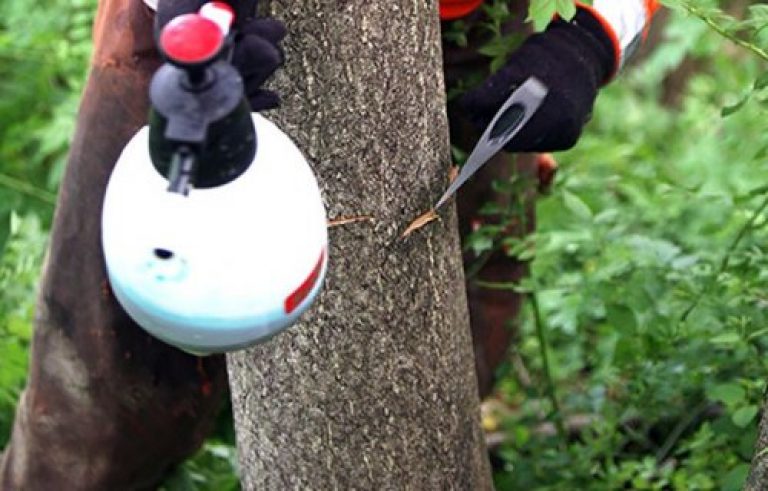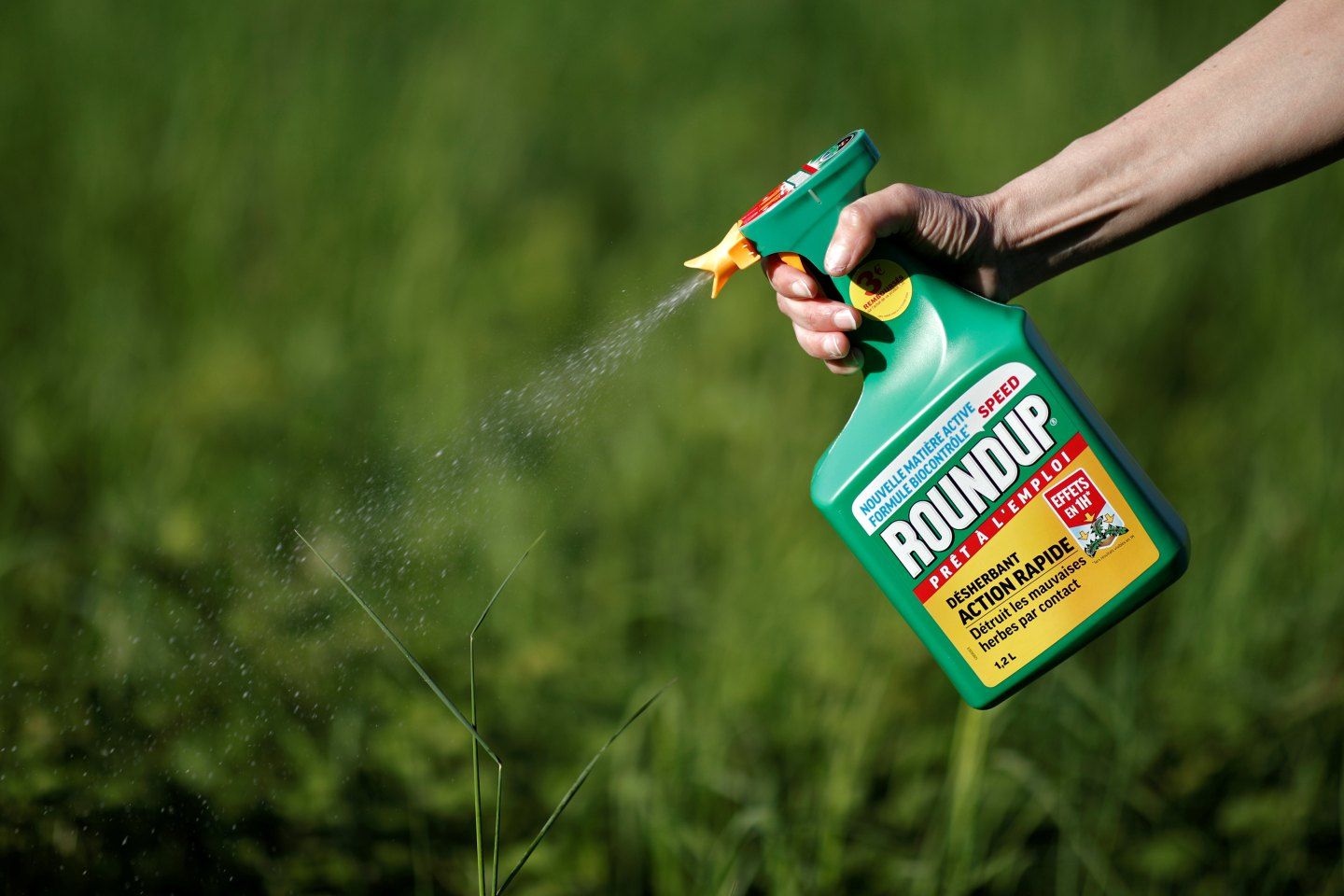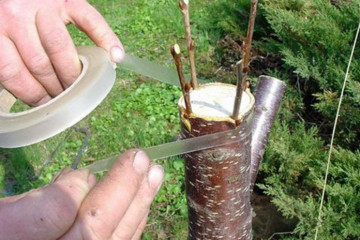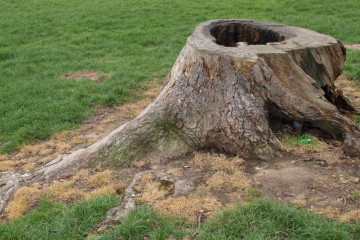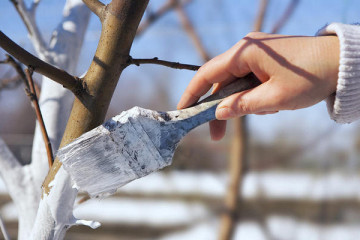Herbicides for the destruction of shrubs and trees
Content:
Destroying excess trees and bushes from a garden plot is not an easy job. This process is difficult to accomplish with one shovel. However, there are special chemicals for killing unnecessary vegetation. They are able to cope with the problem in a short time and with minimal effort.
Methods for using herbicides
Herbicides for the destruction of shrubs and trees act directly on the structure of the plant, helping to get rid of it without cutting it down. After the action of such substances, it remains only to uproot the remaining stump.
A fast-acting herbicide is best used to destroy multiple bushes at once. It can be used in several ways: by treating the soil at the roots, applying it to the bark, injecting it through holes in the wood and by injection.
Adding to soil
Before adding the agent to the soil, it is necessary to water the soil. This promotes better herbicide absorption. Dye is sometimes added to the solution to mark the treated areas. The tool is used to water the soil around the trunk.
The substance can also be applied in powder form by filling in the soil next to the trunk. But it is more effective to bury it in the soil and water it with water.
Application to the bark
This method helps in situations where it is necessary to selectively destroy unnecessary woody vegetation. The product is applied to the bark. This method does not work on trees with thick bark.
The preparation is mixed with oil before application for good absorption. The herbicide is applied in several layers so that the required amount of the substance can be absorbed into the bark.
Through incisions
This method, like the previous one, is suitable for removing bushes and thin-stemmed trees. However, the chemistry will work on thick bark as well if deep cuts are made. The product is applied to dry wood. It is necessary to treat the incisions abundantly with a solution.
Injections
Excessive vegetation can be destroyed by injection. This method spares nearby growing plants from the ingress of chemicals.
First, you need to make holes in the bark. A herbicide is injected into these holes with a special spray device.
Foliage spraying
Leaf processing is required in spring or early fall. In hot weather, the effectiveness of the method decreases. The procedure is carried out in calm weather. It is necessary to thoroughly spray the foliage, not missing a single area. If everything is done correctly, the leaves will begin to turn brown after a short time.
Other tree killing chemicals
In addition to herbicides, other chemicals are used for destruction: arboricides and solutions, independently prepared at home.
Arboricides for tree destruction
Arboricides are herbicides and are aimed at controlling unwanted shrubs on the site. Arboricides are distinguished by a high concentration of substances acting on vegetation. Before starting treatment, you must familiarize yourself with the dosage and safety measures.
Arsenal
To clear the area of unnecessary vegetation, a special preparation is used - arboricide, which is called "Arsenal". The chemical is used to destroy deciduous as well as coniferous trees.
Roundup
Arboricide is widely known for the destruction of weeds of large dimensions called "Roundup". It is used in garden plots, as well as plantings and public parks. The tool copes well with both deciduous and coniferous species.
- cannot be mixed with other drugs.
Sodium nitrate
Sodium nitrate is widely used to remove stumps. It is used to treat the soil around the trunk and the stump itself. Regular treatment with sodium nitrate destroys it in a year. It will dry out completely and be ready to be disposed of.
Ammonium nitrate
The urea contained in ammonium nitrate is very dangerous. The tool destroys wood well. Tillage kills the root, which then turns into a useful fertilizer.
Picloram
The chemical treatment disrupts the process of photosynthesis in plant cells and also stops the synthesis of bioactive acids. Soon the plant wilts, dries up and dies.
Roundup for killing trees
This chemical requires special attention. It was invented in America, but gained popularity all over the world. The unique potent composition of arboricide effectively fights unnecessary vegetation.
Description of the drug
Roundup is sold in three different flavors:
- Normal, with the lowest concentration of active ingredient - 360 grams per liter of water.
- Maximum - 450 grams per 1 liter of water.
- Extra, with the highest concentration - 550 grams is added to 1 liter of water.
Composition of funds and principles of action
The composition of arboricide contains a surfactant that increases the stickiness of the substance, and glyphosate, which slows down the growth of vegetation.
After spraying, the substance penetrates into the plant through the foliage and trunk. Active ingredients help stop growth. After a week, the plant dries up and dies.
What weeds does Roundup fight against?
This arboricide is intended for the following types of weeds:
- cereals;
- thorns;
- dandelions;
- weeds and trees;
- sow thistle;
It is also suitable for other annual and perennial plants that are superfluous on the site.
How to use the drug correctly
Processing is done in calm, dry and clear weather. The older the tree, the more the drug is consumed. When processing, you must wear protective clothing, be sure to cover your hands and face from getting arboricide on the skin. It is important to observe the correct dosage of Roundup indicated on the package.
Pros and cons of Roundup
Advantages:
- high efficiency;
- ease of use;
- low cost;
- long-term action;
- safety for the soil;
- effective against weeds.
Disadvantages:
- high toxicity;
- careless contact with other crops quickly destroys them;
- cannot be mixed with other drugs.
How to water the trees to make them dry
If you can't choose from a store-bought product, than to water the shrub to dry it, try alternative options. You will need potent agents: urea, a strong nitrogen fertilizer concentrate, or gasoline. Instead of gasoline, you can use kerosene as a means to quickly destroy trees and shrubs.
The bushes are well destroyed by urea. The process will be long, but this substance will not poison the soil. For small bushes, oxygen is overlapped to the root system, that is, the near-stem areas are filled with cement.
How to cook poison for plants at home
A good way to get rid of unwanted vegetation is with a vinegar solution. 100 grams of citric acid or lemon juice is added to a liter of 20% vinegar. This solution is sprayed onto the top of the plants.
Using salt
Sodium chloride or table salt is the enemy of vegetation. To prepare the poison, you need to add 2 cups of salt to 4 liters of water. After complete dissolution of the crystals, you need to spray the ground part of the plants.
In fact, getting rid of weeds and bushes is quick and easy. You can prepare an effective plant poison at home. The main thing is to competently approach the procedure, and to carry out the treatment with chemicals very carefully so as not to damage the "necessary" plants.

